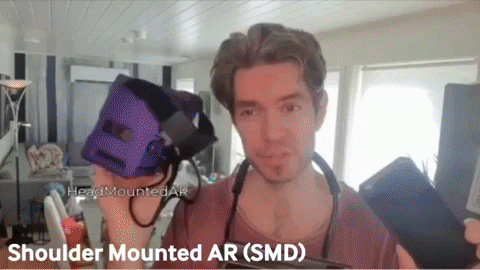Shoulder-Mounted AR: The Next AR Revolution, a good to have, or a Mere Futile Endeavor?
Augmented Reality (AR), though brimming with potential, has its share of challenges. Presently, the dominant forms of AR – head-mounted displays (HMDs) and handheld AR (MAR) – each present unique advantages and issues.
Head-mounted displays give users a highly immersive experience, enveloping them in a 360-degree AR environment. By overlaying digital data onto the user's real-world view, HMDs can provide an unparalleled sense of presence. Yet, these advantages come at a cost. Users often experience visual tunneling, where their field of view is significantly restricted, leading to disorientation. Furthermore, the mismatch between physical and virtual motion can cause simulator sickness, leading to symptoms such as dizziness or even nausea.
On the other hand, handheld AR leverages the ubiquity of smartphones, making AR experiences accessible to a broad audience. Interacting with AR content directly via touch screens makes handheld AR highly intuitive. Nevertheless, constant physical engagement with a device can be tiring for users. Holding the device up for prolonged periods and interacting with the screen can be physically demanding. Moreover, handheld AR often requires interaction with tangible objects which can add layers of complexity, requiring physical effort and dexterity from the end users.
To mitigate these challenges, I have experimented with a new method of AR interaction - shoulder-mounted AR, in a form of a shoulder-mounted mobile holder, running my mobile AR prototypes. This approach aims to provide an immersive experience similar to HMDs while mitigating limitations. By locating the AR display on the user's shoulder, it offers a wider field of view, thus addressing the issue of visual tunneling. Additionally, it reduces the incidence of simulator sickness by better aligning real-world and virtual movements, giving the users a rapid and flexible option to break the “full immersion.”
Shoulder-mounted AR also overcomes the challenges associated with handheld AR. By freeing up the users' hands, it removes the physical strain associated with holding a device, and without the need for continuous screen interaction, it simplifies the overall interaction process.
However, this novel approach brings with it new potential obstacles. How comfortable is it for users to carry a device on their shoulders? How stable is the device in this position? What are the most effective ways to interact with this kind of AR?
Is shoulder-mounted AR the game-changing solution it is set out to be, or is it just good to have, or is it just a futile endeavor? My future research will delve into these questions, aiming to validate the practical relevance and applicability of shoulder-mounted AR. Through extensive testing and user feedback analysis, I aspire to determine real-world feasibility.
Stay tuned as we take the plunge into this innovative realm!
AR, HMDs, handheld AR, visual tunneling, simulator sickness, shoulder-mounted AR, field of view, user comfort, device stability, interaction methods
